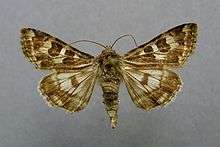Schinia scutosa
Schinia scutosa, the spotted clover, is a moth of the family Noctuidae. It is found from Europe to southern Siberia, the Near East and the Middle East and from central Asia to Japan. In North Africa it is found from Morocco to Egypt.

| Spotted clover | |
|---|---|
 | |
| Scientific classification | |
| Kingdom: | |
| Phylum: | |
| Class: | |
| Order: | |
| Family: | |
| Genus: | |
| Species: | S. scutosa |
| Binomial name | |
| Schinia scutosa (Denis & Schiffermüller, 1775) | |
| Synonyms | |
| |
Technical description and variation
The wingspan is 30–36 mm. Forewing dull whitish, the marginal areas speckled olive-brown; stigmata all large and conspicuous, brown with black outlines; a brown band between the dark outer and white subterminal lines; hindwing white, the veins brown; a broad dark marginal border, with two pale spots between 2 and 4, preceded by a sinuous outer line; a large black discoidal lunule.[1]
Biology
Adults are on wing from July to September. There are two generations per year in southern Europe.
Larva dark green, the sides and venter yellow; lines yellow, the subdorsal freckled with black; head yellow with black spots. The larvae feed on Artemisia species, including Artemisia vulgaris, Artemisia campestris, Artemisia scoparia, Artemisia abrotanum and Artemisia dracunculus.[2]
Taxonomy
Schinia scutosa was placed as a synonym of North American species Schinia nuchalis, but was treated as a separate species by Hardwick in 1996. Many authors place Schinia scutosa in the genus Protoschinia.
References
- Seitz, A. Ed., 1914 Die Großschmetterlinge der Erde, Verlag Alfred Kernen, Stuttgart Band 3: Abt. 1, Die Großschmetterlinge des palaearktischen Faunengebietes, Die palaearktischen eulenartigen Nachtfalter, 1914
- "Robinson, G. S., P. R. Ackery, I. J. Kitching, G. W. Beccaloni & L. M. Hernández, 2010. HOSTS - A Database of the World's Lepidopteran Hostplants. Natural History Museum, London".
External links
| Wikimedia Commons has media related to Protoschinia scutosa. |
- Spotted clover on UKmoths
- Funet Taxonomy
- Lepiforum.de